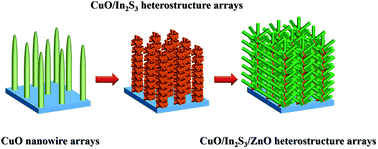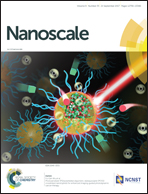Construction of CuO/In2S3/ZnO heterostructure arrays for enhanced photocatalytic efficiency†
Abstract
Novel one-dimensional (1D) heterostructure arrays composed of CuO nanowire cores, intermediate In2S3 nanostructures, and ZnO nanorod sheaths (i.e. CuO/In2S3/ZnO heterostructure arrays) have been successfully synthesized by a multi-step process. First, single-crystalline CuO nanowires were directly grown on flexible Cu mesh substrates using a one-step annealing process under ambient conditions. Second, In2S3 nanostructures and ZnO nanorods were sequentially grown on the CuO nanowires by a two-step hydrothermal method at low reaction temperature. The morphology, crystal structures, and optical properties of the CuO/In2S3/ZnO heterostructure arrays were studied by scanning electron microscopy, X-ray diffraction, transmission electron microscopy, energy-dispersive spectroscopy, and photoluminescence spectroscopy. The resultant ternary CuO/In2S3/ZnO heterostructure arrays exhibit excellent photocatalytic activity in the photodegradation of rhodamine 6G (R6G) under 10 W UV light irradiation, which is much higher than that of single-component (CuO nanowire arrays) or two-component systems (CuO/In2S3 heterostructure arrays). Furthermore, the reusability test demonstrates that the CuO/In2S3/ZnO heterostructure arrays on the Cu mesh still maintain high photocatalytic activity in the degradation of three kinds of organic pollutants even after five cycles, without any significant decline. These findings provide an insight into the design and synthesis of new CuO-based composites to effectively improve their photocatalytic performance.



 Please wait while we load your content...
Please wait while we load your content...